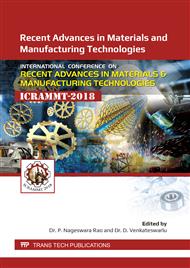p.415
p.421
p.427
p.433
p.439
p.444
p.451
p.461
p.466
Fullerene (PCBM) Modulated MEH-PPV Photoactive Material for Plastic Solar Cells
Abstract:
Abstract.Plastic solar cells are promising devices in looking for low cost and flexible energy storing devices. Low efficiency is the main drawback of these cells in comparison with inorganic solar cells and hence the search for an efficient plastic solar cell has become a globally demanded research problem. In the present work we have used the modified fullerene [6,6]-Phenyl C61 butyric acid methyl ester (PCBM) as N type modulating probe on P type semiconducting polymer Poly[2-methoxy-5-(2’-ethylhexyloxy)-phenylenevinylene] (MEH-PPV). The donor MEH-PPV polymer matrix is modulated by adding PCBM in the weight ratio 1:3, 1:1 and 3:1 in Chloro-Benzene(CB) as the common solvent and glass-coated samples are prepared by solution cast method. Samples are analyzed by UV-VISIBLE spectroscopy by JASCO UV Vis NIR V 670 spectrometer. The effect of PCBM content on MEH-PPV is to broaden the spectral response of MEH-PPV. In other words the acceptor PCBM has tuned the band gap (energy difference between HOMO & LUMO) of the donor MEH-PPV. Spectral analysis revealed that 1:3 blend of MEH-PPV with PCBM has a wide spectral sensitivity for absorption. The band gap for each blend is determined using Tauc’s plot. Increased Fullerene content has decreased the band gap of the host polymer. We conclude that modified fullerene can effectively modulate the donor polymer matrix and 1:3 MEH-PPV: PCBM can act as a good photoactive material for solar cells. Absorption can be further enhanced by either dye sensitization or by metal oxide nanoparticle doping without increasing the thickness of the film. We have doped the optimized 1:3 blend with 20%, 40% & 60% of TiO2 nanoparticles wherein the absorption is enhanced with doping level. The increased absorption is attributed to the photocatalytic activity of the nanaoparticles embedded in the polymer matrix
Info:
Periodical:
Pages:
439-443
Citation:
Online since:
August 2019
Authors:
Price:
Сopyright:
© 2019 Trans Tech Publications Ltd. All Rights Reserved
Share:
Citation:


